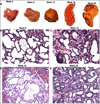A mouse model of cholestasis-associated cholangiocarcinoma and transcription factors involved in progression
- PMID: 21440549
- PMCID: PMC3129489
- DOI: 10.1053/j.gastro.2011.03.044
A mouse model of cholestasis-associated cholangiocarcinoma and transcription factors involved in progression
Abstract
Background & aims: Cholestasis contributes to hepatocellular injury and promotes liver carcinogenesis. We created a mouse model of chronic cholestasis to study its effects on progression of cholangiocarcinoma and the oncogenes involved.
Methods: To induce chronic cholestasis, Balb/c mice were given 2 weekly intraperitoneal injections of diethylnitrosamine (DEN); 2 weeks later, some mice also received left and median bile duct ligation (LMBDL) and, then 1 week later, were fed DEN, in corn oil, weekly by oral gavage (DLD). Liver samples were analyzed by immunohistochemical and biochemical assays; expression of Mnt and c-Myc was reduced by injection of small inhibitor RNAs.
Results: Chronic cholestasis was induced by DLD and accelerated progression of cholangiocarcinoma, compared with mice given only DEN. Cystic hyperplasias, cystic atypical hyperplasias, cholangiomas, and cholangiocarcinoma developed in the DLD group at weeks 8, 12, 16, and 28, respectively. LMBDL repressed expression of microRNA (miR)-34a and let-7a, up-regulating Lin-28B, hypoxia-inducible factor (HIF)-1α, HIF-2α, and miR-210. Up-regulation of Lin-28B might inhibit let-7a, which is associated with development of cystic hyperplasias, cystic atypical hyperplasias, cholangiomas, and cholangiocarcinoma. Knockdown of c-Myc reduced progression of cholangiocarcinoma, whereas knockdown of Mnt accelerated its progression. Down-regulation of miR-34a expression might up-regulate c-Myc. The up-regulation of miR-210 via HIF-2α was involved in down-regulation of Mnt. Activation of the miR-34a-c-Myc and HIF-2α-miR-210-Mnt pathways caused c-Myc to bind the E-box element of cyclin D1, instead of Mnt, resulting in cyclin D1 up-regulation.
Conclusions: DLD induction of chronic cholestasis accelerated progression of cholangiocarcinoma, which is mediated by down-regulation of miR-34a, up-regulation miR-210, and replacement of Mnt by c-Myc in binding to cyclin D1.
Copyright © 2011 AGA Institute. Published by Elsevier Inc. All rights reserved.
Conflict of interest statement
Figures







Comment in
-
Myc, Max, and Mnt: molecular mechanisms of enhancement of cholangiocarcinogenesis by cholestasis.Gastroenterology. 2011 Jul;141(1):32-4. doi: 10.1053/j.gastro.2011.05.022. Epub 2011 May 26. Gastroenterology. 2011. PMID: 21620848 Free PMC article. No abstract available.
References
Publication types
MeSH terms
Substances
Grants and funding
LinkOut - more resources
Full Text Sources
Other Literature Sources
Medical
Research Materials
Miscellaneous

